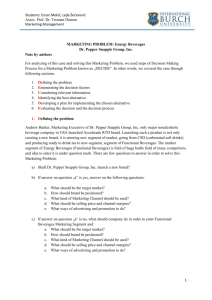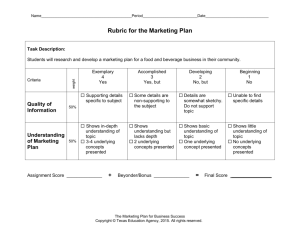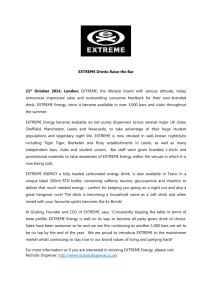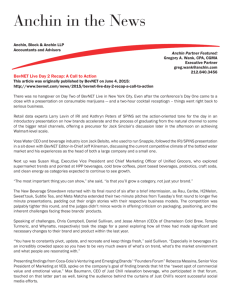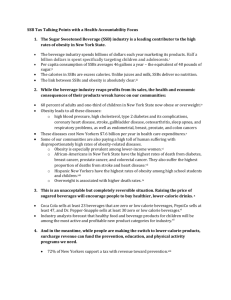Case study: Dr. Pepper Snapple Group Inc. Energy Beverages
advertisement
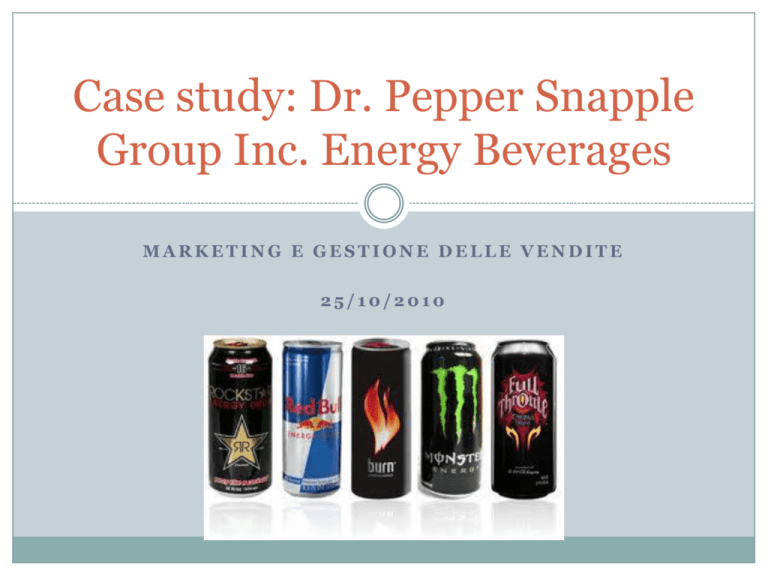
Case study: Dr. Pepper Snapple Group Inc. Energy Beverages MARKETING E GESTIONE DELLE VENDITE 25/10/2010 Summary The Case The Company The Energy Beverage Market in the US Marketing Plan Considerations What Shall He Do Now? The Case In 2007, Andrew Barker is charged with assessing whether or not a profitable market opportunity exist for a new energy beverage brand to be produced, marketed, and distributed by the company in 2008 Energy beverages are broadly defined as “drinks that provide a consumer with a boost of energy” The decision to explore a new energy beverage is part of a corporate business strategy, which aims at focusing on opportunities in high-growth beverage businesses. As part of this strategy, Dr Pepper Snapple Group, Inc. has previously launched the Accelerade RTD brand, a readyto-drink sport drink Energy beverages vs. Sport drinks Energy drinks are considered functional beverages Other functional beverages include sport drinks, ready-to-drink tea, enhanced fruit drinks, soy beverages, and enhanced water Andrew Barker believes that the decision to introduce the Accelerade RTD brand into a new beverage market for the company (sport drinks) is similar to the situation he faced with recommending whether or not Dr Pepper Snapple Group, Inc. should introduce a new branded product into the energy beverage market The Company Integrated brand owner, bottler, and distributor of nonalcoholic beverages in the US, Mexico, and Canada In 2007, 89% of company net sales are generated in the US, 4% in Canada, and 7% in Mexico and the Caribbean The Company In the US and Canada, Dr Pepper Snapple Group, Inc. participates primarily in the flavored carbonated soft drink (CSD) market segment The Company In the non-CSD market segment in the US, the company participates primarily in the ready-to-drink teas, juice drinks, and mixer categories The Company In Mexico and the Caribbean, the company participates primarily in the carbonated mineral water, flavored CSD, bottled water, and vegetable juice categories The Company 7 Key strengths Strong portfolio of leading consumer-preferred brands Integrated business model Strong customer relationships Attractive positioning within a large, growing, and profitable market Broad geographic manufacturing and distribution coverage Strong operating margins and significant, stable cash flows Experienced executive management team The Company Business strategy: 6 Key elements Build an enhance leading brands Focus on opportunities in high-growth and high-margin categories Increase presence in high-margin channels and packages Leverage the company’s integrated business model Strengthen the company’s route-to-market through acquisitions Improve operating efficiency The energy beverage market in the US 4th largest nonalcoholic beverage category, after carbonated soft drinks, sport drinks, and bottled water, but the fastest growing one Defined by major brands, including Red Bull, Monster Energy, and Rockstar From 2001 to 2006, total energy beverage retail sales grew at an average annual rate of 42.5% However, industry analysts project an average annual growth rate of 10.2% from 2007 to 2011, which is attributed to market maturity, increased price and packaging competition, and the entrance of hybrid energy beverages, such as energy water, energy fruit drinks, ready-to-drink energy teas, and energy colas The energy beverage market in the US The energy beverage consumer Average US per capita consumption of energy beverage drinkers increased by 14% since 2004 Gender: males Ages: 12 - 34 When: afternoon followed by morning consumption Where: at home, in the car, and at work/school Why: energy boost, mental alertness, refreshment, and taste What: energy beverage consumers limit their choice to only 1.4 different brands, on average => strong brand loyalty The energy beverage market in the US Channels Convenience stores (81% in 2004 -> 74% in 2006 ) and supermarkets (11% in 2004 -> 14% in 2006) are the dominant off-premise retail channels for energy beverages Industry analysts expect continued sales erosion in the convenience channel in the future Companies with a broad product line and an extensive distribution network have had the greatest success in gaining shelf space in supermarkets and mass merchandisers for their brands Product turnover is a key consideration among convenience stores => Only brands with a limited product line that can demonstrate high turnover are stocked The energy beverage market in the US Major competitors: Red Bull North America Market pioneer since 1997 Market leader in dollar sales and unit volume Decline from 82% in 2000 to 43% in 2006, due to the entry of new, aggressive competitors, and brands with lower prices $39.6 million US media expenditure in 2006 and an estimated $60.9 million in 2007 The energy beverage market in the US Major competitors: Hansen Natural Corporation Monster Energy is its most prominent energy drink since 2002 Monster Energy sales have benefited from recent distributions agreements: AnheuserBusch wholesalers distribute the brand to retailers in different territories (e.g., bars, nightclubs, restaurants) in the US; PepsiCo Canada will be the exclusive master distributor in Canada $61,1oo US media expenditure in 2006 and an estimated $153,800 in 2007 The energy beverage market in the US Major competitors: Pepsi-Cola Division of PepsiCo, which markets AMP Energy since 2001 and SoBe Adrenaline Rush since 2003 Both are marketed through the PepsiCola distribution system in the US No significant media expenditure in 2006 The energy beverage market in the US Major competitors: Rockstar, Inc. Rockstar Energy brand was introduced in 2001 and distributed in the US and Canada by the Coca-Cola Company, except in the Pacific Northwest and Northern California where Rockstar retains its original distributors Minimal media expenditure in 2006 and $41,500 estimated for 2007 The energy beverage market in the US Major competitors: Coca-Cola The Coca-Cola Company markets the Full Throttle since 2003 and sugar-free Tab Energy brands since 2006 through its distribution network The company has been acquiring smaller energy beverage brands and pursuing licensing agreements to distribute independent brands, such as Rockstar Full Throttle was supported by $7.3 million in US media expenditure in 2006 and an estimated $492,300 in 2007. The Tab Energy introduction was supported by $12.6 million US media expenditure in 2006 and $20,500 are estimated for 2007 The energy beverage market in the US Major competitors: Estimated 2006 Dollar Sales 10% Red Bull 6% 43% 12% 13% 16% Hansen Natural Corporation (Monster Energy) Pepsi-Cola (SoBe Adrenaline Rush; AMP Energy) Rockstar Coca-cola (Full Throttle; Tab Energy) Others (including private labels) The energy beverage market in the US Major competitors: Estimated 2006 Unit Volume Market Share 10% Red Bull 6% 30% 17% Hansen Natural Corporation (Monster Energy) Pepsi-Cola (SoBe Adrenaline Rush; AMP Energy) Rockstar 10% 27% Coca-cola (Full Throttle; Tab Energy) Others (including private labels) The energy beverage market in the US Product proliferation Line extensions (e.g., sugar-free versions, different flavors) New packaging and sizes (e.g., from the original 8.3-ounce Red Bull package to 16-ounce and 24-ounce packages) Market segmentation (e.g., Tab Energy targeted at women, Full Throttle Demon sub-brand targeted at young Hispanic men) The energy beverage market in the US Price erosion: prices declined 30% from 2001 to 2006 Larger package sizes that have a lower price per ounce The introduction of multi-packs, which offer a lower price per ounce Increasing availability in supermarkets and mass merchandisers, including Wal-Mart, which operate with lower retail gross margins than convenience stores The energy beverage market in the US Average retail selling price per case for brands in major offpremise retail channels in late 2007, according to ACNielsen Brand All off-premise channels Supermarkets and mass merchandisers only Convenience stores only Red Bull $68.00 $63.00 $70.00 Monster Energy $37.00 $32.00 $39.00 Rockstar $37.00 $32.00 $38.00 Full Throttle $36.00 $32.00 $38.00 AMP Energy $38.00 $35.00 $39.00 Tab Energy $49.00 $45.00 $55.00 Channel Average $44.00 $40.00 $46.00 Andrew Barker… Marketing Strategy Marketing Plan considerations Target 43 million energy drink users in the US (about 18% of the US population 12 years of age or older) Males between the ages of 12 and 34 the heaviest users of energy beverages (about 70% of energy beverage consumption) Only Tab Energy focuses on female consumers Marketing Plan considerations Product Line Regular energy beverages have an 80% share of the market, sugar-free has 20% Sizes range from 8.3 ounces (Red Bull) to 24 ounces. The 16-ounce size, representing about 50% of case sales in convenience stores, has posted the fastest growth (150% since 2004) Marketing Plan considerations Brand Positioning Energy boost Mental alertness Refreshment Taste Marketing Plan considerations Marketing channel The company delivers to all types of off-premise retailers where energy beverages are sold Company bottlers and distributors do not serve all areas of the US (by early 2008, 80% of the US market) Dr Pepper Snapple Group, Inc. is distributing Monster Energy in selected US territories on behalf of Hansen Natural Corporation in 2007, but this distribution will end effective November 10, 2008 Marketing Plan considerations Manufactures suggested retail selling price and channel margins Single-serve energy beverage drink retail prices have generally settled at roughly $2.00 per single-serve package, regardless of package size Estimated retail, wholesale, and manufacturer energy beverages margins, on a per case basis, vary within a fairly tight range Retailers typically report gross margins in the range of 40% (for supermarket) to 50% (for convenience stores), based on the manufacturer’s suggested retail price Wholesalers (distributors and bottlers) typically report a gross margin of 30% to 36% of the price sold to retailers Manufacturers typically obtain a gross margin between 60% and 66% on sales to wholesalers Marketing Plan considerations Advertising and Promotion Except for Red Bull, brand media advertising in the energy beverage market is modest Instead, competitors rely on promotional vehicles such as brand Web sites, events, and sponsorships In 2006, the top 5 competitors spent about $70 million for advertising media, but the expenditures for other promotional vehicles were 4 to 6 times higher than media expenditures Lessons from the Sports Drink Market US Sports Drink Market In 2006, Gatorade, marketed by Pepsi-Cola, was the sports drink market pioneer and the perennial market share leader Powerade, marketed by Coca-Cola, had an 18% market share Each brand was distributed through its company’s extensive distribution network that serves convenience stores, supermarkets, mass merchandisers, and a variety of other retailers Lessons from the Sports Drink Market Accelerade Part of an asset purchase agreement by the company whereby Pacific Health Laboratories, Inc., the original brand owner, received a royalty payment for a period and a royalty free license to continue selling Accelerade and Endurox through health and nutrition outlets Accelerade was already popular with hardcore athletes given its 4:1 ratio of carbohydrate to protein and documented benefits in terms of improved endurance, enhanced rehydration, faster muscle recovery, and less postexercise muscle damage Lessons from the Sports Drink Market Accelerade RTD Brand Launch Channels: Convenience stores, supermarkets, and mass merchandisers Target: 35 millions Americans who exercised regularly and were concerned about being competitive Product line: 20-ounce single-serve package in 4 flavors Suggested Retail Price: $2.79, roughly twice the price of a 20ounce Gatorade single-serve package, with premium price attributed to Accelerade’s unique point of difference: the first protein-enhanced sports drink Advertising and Promotion: brand Web site, podcasts, searchengine marketing, and a chat-room – “Sweat Smarter” What shall he do now? Marketing decisions Target Product line and Positioning Choice Marketing Channel Choice Advertising and Promotion Pricing and Profitability Target Selection All energy drink users or only heavy users? Should a select customer group be targeted, as Coca- Cola had done with Tab Energy in 2006? Target Selection Age: 35-44 (25% users) Gender: M adult (17% users) Race and ethnicity: Caucasian (12% users) Product Line Choice Should he introduce the brand in a single-serve package or in a multi-pack? What package size(s) should he choose: 8-ounce, 16ounce, or 24-ounce? Should he offer both a regular and sugar-free version? How many flavors should be introduced: one or two? Product Line Choice Single-serve 16-ounce Regular and sugar-free version Two flavors Positioning Choice Energy drink positioning typically focuses on providing an energy boost, mental alertness, refreshment, and taste for males 12 to 34 Does an opportunity exist to differentiate a new energy brand on the basis of packaging or ingredients? 16.9-ounce (5 liter) single-serve shape with a resealable screw cap Augment the “energy” and “mental alertment” by increasing the amount of caffeine, herbs, and B vitamins per 8-ounce serving Adult energy drink Head-to-head positioning against competitors Positioning Choice Differentiation of the product on the basis of ingredients (e.g., lower carbohydrates) => “Light” energy drink Channel Choice The company supplies both off-premise and on-premise retailers. Andrew believes that off-premise retailers represent the best choice. However, a decision has to be made about which retailers to serve initially Should all off-premise retailers be served or should distribution for a new energy drink brand focus on convenience stores only or supermarkets and mass merchandisers only? Channel Choice All off-premise channels First, only supermarkets and mass merchandisers, then, convenience stores too Advertising and Promotion Choice An introductory media advertising and promotion expenditure seems to be necessary to launch a new energy drink brand Brand awareness Brand trial Expenditure for other promotional vehicles also warrant consideration and funding Advertising and Promotion Choice High media expenditure for the first year (at least) Expenditure for other promotional vehicles (Web, communities, sponsorships, product placements), but not so much because the product is targeted to adults and not to young Pricing and Profitability Retail prices in the energy beverage market had settled in a range around $2.00 per single-serve package, regardless of package size. However, Andrew could recommend a higher or lower price The pricing decision, expected unit volume, trade and brand margins, and marketing plan decisions and expenditures would factor into his assessment as to whether or not a profitable market opportunity exists for a new energy beverage brand Pricing and Profitability Higher price because the product is differentiated What really happened? Venom Energy Packaging differentiation: The only energy drink to use a thick aluminum bottle and a resealable screw cap! In 2008, Venom Energy entered into a partnership with the Arena Football League to promote the product during the 2008 playoffs on ESPN and ABC Venom Energy contains large doses of taurine, glucuronolactone, and guarana, with Lcarnitine, inositol and maltodextrin as additional ingredients. The caffeine content of Venom energy drinks is roughly 162 mg per bottle, or approximately equal to that found in 8-ounces of plain Starbucks coffee Venom Energy The company sponsors the Andretti Autosport IndyCar Series team with driver Marco Andretti, Pavel Datsyuk of the Detroit Red Wings, Maxime Talbot of the Pittsburgh Penguins and Milan Lucic of the Boston Bruins, all from the NHL as well as Jordan Farmar of the New Jersey Nets (NBA) and Lance Berkman of the New York Yankees Venom Energy Grazie per l’attenzione!
